To effectively get rid of pigeons on your roof, consider using bird spikes, netting, or bird slopes. It’s vital to choose humane methods and always adhere to local regulations and guidelines.
Table of contents
What are Pigeons?
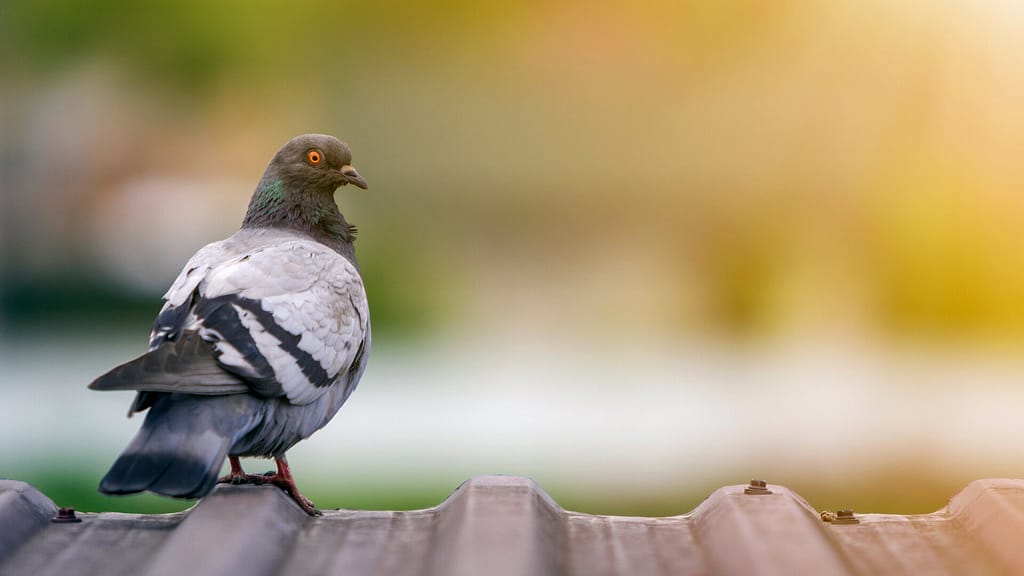
Pigeons, often seen fluttering about city squares or perched on architectural structures, are an integral part of the urban landscape. But who exactly are these ubiquitous birds that so seamlessly fit into our urban lives?
Origin and Evolution
Pigeons, scientifically known as Columba Livia, are believed to have their origins in the coastal regions of South Asia and North Africa. They’ve been around for millions of years, evolving from wild rock doves that preferred rocky cliffs and outcrops.
With the advent of civilization and the construction of buildings, these birds adapted, finding skyscrapers and building ledges similar to their natural habitats.
Physical Characteristics
Pigeons are medium-sized birds with a stocky build. They have short legs, a compact body, and a small head. Their plumage can vary, but the most common urban pigeon has a bluish-grey appearance with two dark wing bars and a characteristic iridescent neck, shimmering with green and purple hues.
Adaptability and Survival
One of the most admirable traits of pigeons is their adaptability. They are among the few bird species that have seamlessly thrived in urban settings.
Moreover, their life cycle plays a pivotal role in their urban proliferation. Interestingly, young pigeons, or squabs, become independent just four to six weeks after birth. As a result, this swift maturation cycle significantly contributes to their rapid growth in numbers, often resulting in sizable populations in metropolitan areas.
Why Do Pigeons Love Rooftops?
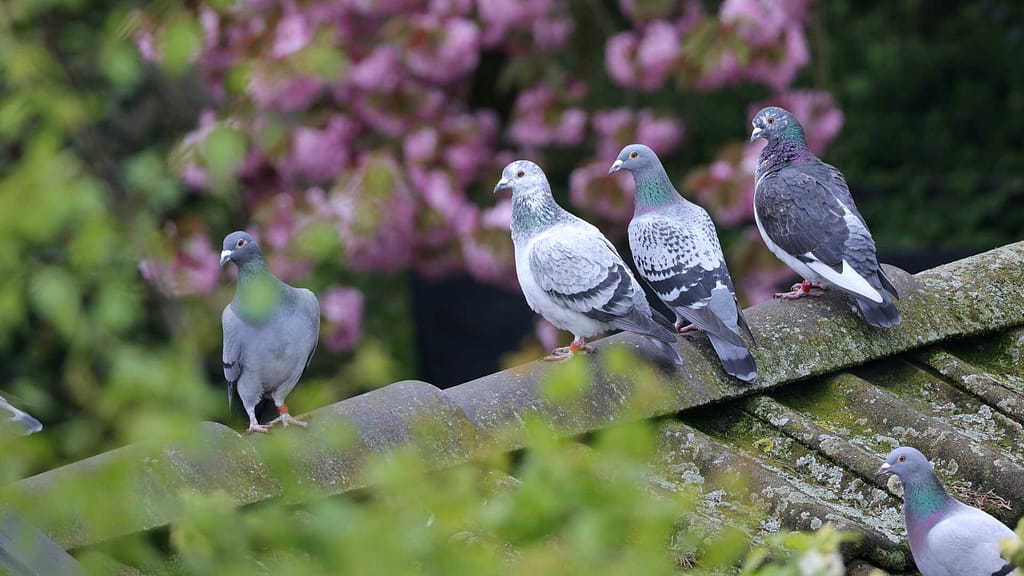
When you picture the cityscape, pigeons almost inevitably line up gracefully on building ledges or rooftops. This preference for high places isn’t just a mere coincidence; it ties directly to the pigeon’s history and behavior. Let’s dive into why these birds find rooftops so attractive.
Evolutionary Habitats
Modern city pigeons descended from wild rock doves that nested on cliff edges and rocky terrains. The sheer vertical faces of cliffs protected them from many ground-based predators. Today’s buildings, with their tall structures, protruding ledges, and roof flashing that might accumulate small pockets of water or food, mimic these natural habitats. So, pigeons instinctively gravitate towards such heights in cities.
Safety in Elevation
Rooftops give pigeons a vantage point, offering a sweeping view of their surroundings. From this elevated position, they can detect predators or dangers from a distance and swiftly exit when needed.
Warmth and Shelter
Concrete and brick buildings retain heat. To pigeons, rooftops serve as warm refuges during cold spells and cozy resting spots at night. Overhanging ledges or rooftop equipment also shield them from harsh weather conditions, whether rain or intense sun.
Nesting Grounds
Because rooftops offer both safety and shelter, pigeons often choose them as perfect nesting spots. The secluded corners, ledges, and sometimes the machinery up there become prime real estate for building nests, laying eggs, and nurturing their young, away from the busy streets.
Proximity to Food Sources
The height of rooftops not only ensures safety and shelter but also gives pigeons a bird’s-eye view to identify potential food sources. From their perch, they can keenly watch human activities, ready to swoop down for opportunities like leftover food or open trash bins.
How Pigeons Affect Your Roof?
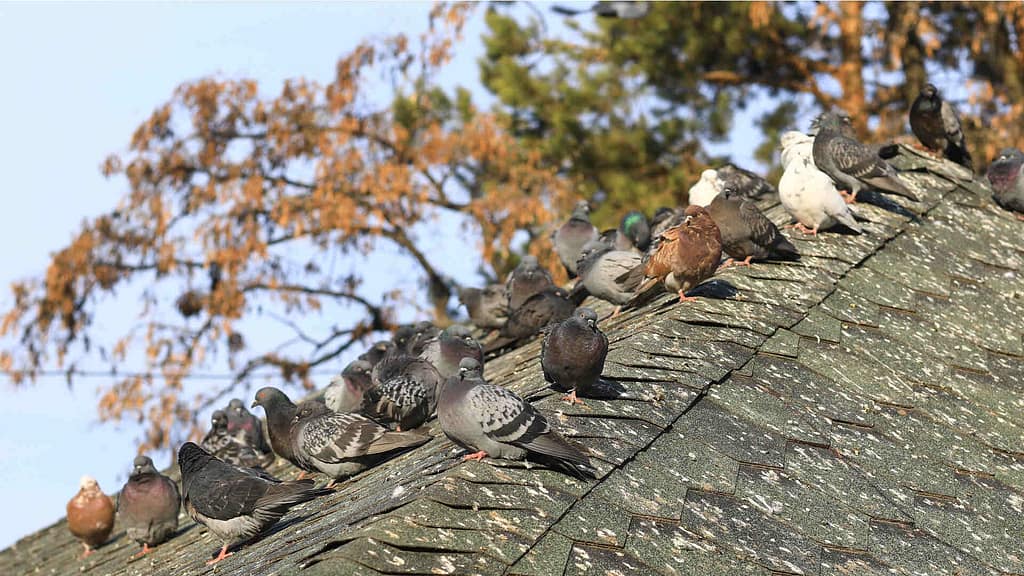
While pigeons are a common sight on urban rooftops, their continuous presence can have several repercussions for homeowners. While they might seem harmless from a distance, let’s discuss the various ways pigeons can impact your roof’s health and aesthetics.
- Droppings: Pigeon droppings are a noticeable consequence of their presence. They’re unsightly and possess acidic properties that erode roofing materials. Continuous accumulation weakens the roof structure, reducing its lifespan.
- Nesting Debris: Pigeons use twigs, leaves, and urban debris to build their nests. This material can obstruct drainage systems and gutters, causing water buildup and potential roof damage. If unchecked, water may seep into underlying layers, resulting in leaks and structural issues. Over time, this can significantly increase the roof replacement cost for homeowners.
- Attraction of Other Pests: Pigeon nests can attract various pests like mites, ticks, and beetles. These secondary pests might invade homes, leading to additional infestations and related health risks.
- Damage to Roofing Equipment: Pigeons can negatively impact air conditioning units, solar panels, and other rooftop installations. They might nest under these units, leading to overheating or malfunction. Their droppings can also corrode these installations’ metal parts.
- Health Hazards: Apart from structural issues, pigeons carry diseases such as salmonellosis, histoplasmosis, and psittacosis. If their droppings contact ventilation systems, these diseases can spread within houses, posing health threats.
- Aesthetic Concerns: Roofs marred by pigeon droppings and nesting materials are unsightly.
- Noise Disturbance: A sizable pigeon flock can cause significant noise, particularly during mating seasons. Their cooing, flapping, and other activities can disrupt those residing directly beneath.
What To Do: Common Solutions in Pigeon Control
Pigeons are an integral part of our urban landscape. However, their increasing numbers can lead to various challenges. Addressing pigeon-related issues effectively requires a deep understanding of the various solutions available. Let’s explore some of the most common and humane methods to manage and deter these birds, weighing both their advantages and potential drawbacks.
Bird Spikes
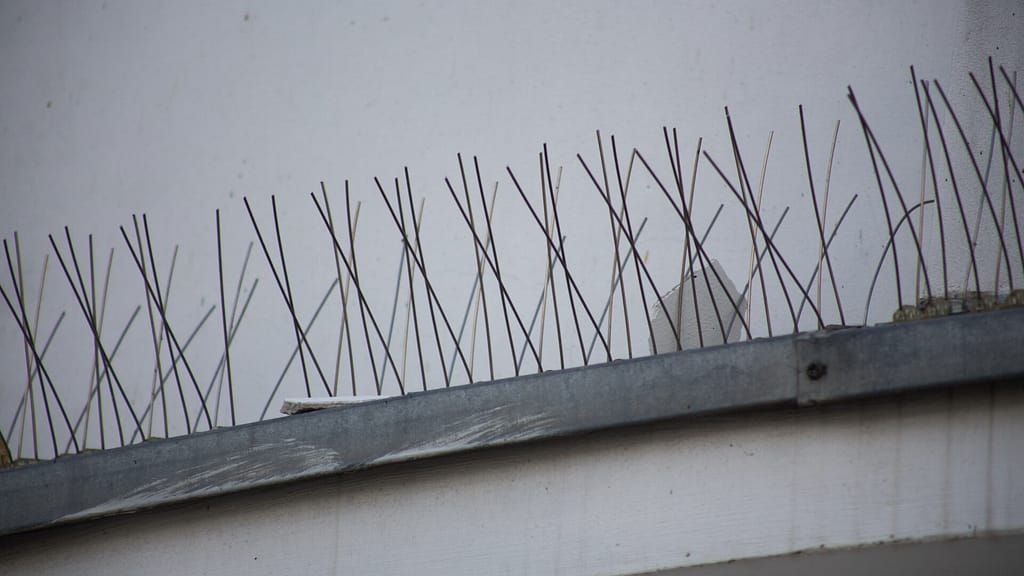
One of the more common deterrents, bird spikes are designed to prevent pigeons from roosting on ledges, rooflines, and other perching spots. While they offer a passive and long-term solution that doesn’t harm the birds, there are some potential issues.
Over time, debris such as leaves or trash can accumulate between the spikes, negating their deterrent effect. Additionally, some property owners might find their appearance unsightly, which could affect the overall aesthetic of a building or structure.
Netting
Bird netting serves as a physical barrier, denying pigeons access to large areas where they might roost or nest. This method is particularly effective for balconies, courtyards, or roof sections. However, it comes with its set of challenges. Netting requires regular inspection and maintenance to ensure there are no gaps or tears. Moreover, if not properly installed, birds can become trapped, leading to unintentional harm or even death.
Bird Slopes
These angled, slick panels deter pigeons from perching on surfaces such as ledges or beams. While effective in many instances, their positioning is crucial. If not correctly placed, their deterrent capability can be compromised. Moreover, they might not align well with a building’s design, posing aesthetic concerns.
Reflective Objects

Reflective objects, whether CDs, foil tapes, or specially designed bird discs, utilize light to disorient and scare away pigeons. However, over time, there’s the possibility that pigeons might grow accustomed to the reflections, diminishing the strategy’s effectiveness. Furthermore, these objects may not blend seamlessly with the architectural design of a property, potentially creating visual distractions.
Ultrasonic Devices
By emitting frequencies unpleasant for pigeons but typically inaudible to humans, ultrasonic devices aim to make environments inhospitable for these birds. But they’re not without their issues. They might interfere with other electronic devices, and if not calibrated correctly, the emitted sounds could become bothersome to humans.
Gel Repellents
These non-toxic gels deter pigeons due to their sticky texture. However, the gel’s efficacy can wane over time, requiring frequent reapplications. In hotter climates, there’s also the risk of the gel melting, creating a potential mess.
Falconry
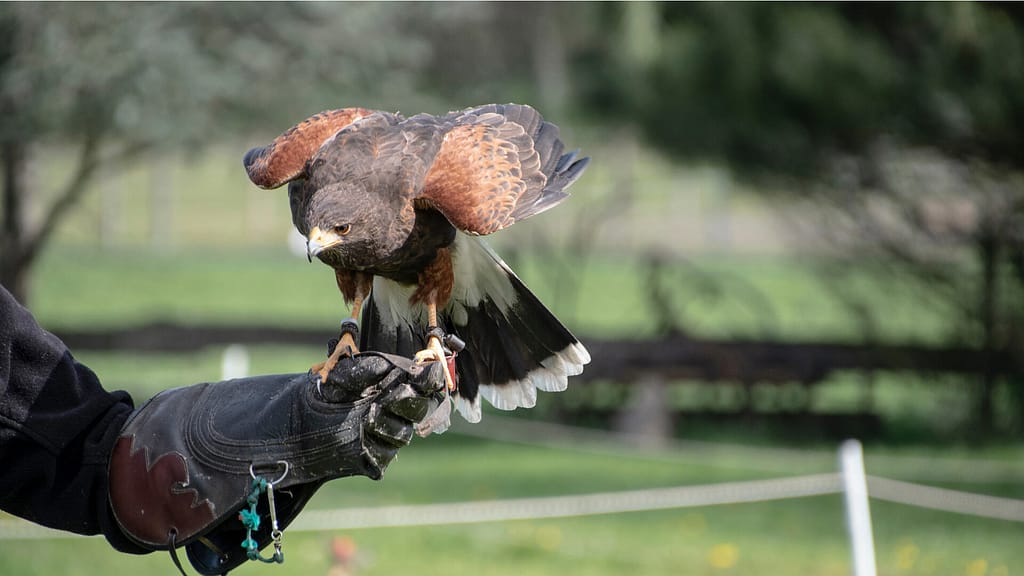
Employing the ancient art of falconry involves using trained birds of prey, like falcons or hawks, to deter or control pigeon populations. The very presence of these natural predators can intimidate pigeons, pushing them to seek out safer territories.
While effective, falconry requires skilled handlers who are trained in managing these birds of prey. This specialized skill set often comes at a significant cost. Engaging falconers for pigeon control, especially on a regular basis, might be more expensive than other methods, and the costs can vary based on frequency, location, and the specific needs of the area.
Furthermore, falconry might not be suitable for all urban settings. Ethical questions also arise when using one species to control another, adding another layer of consideration when weighing the viability of this method.
Trapping
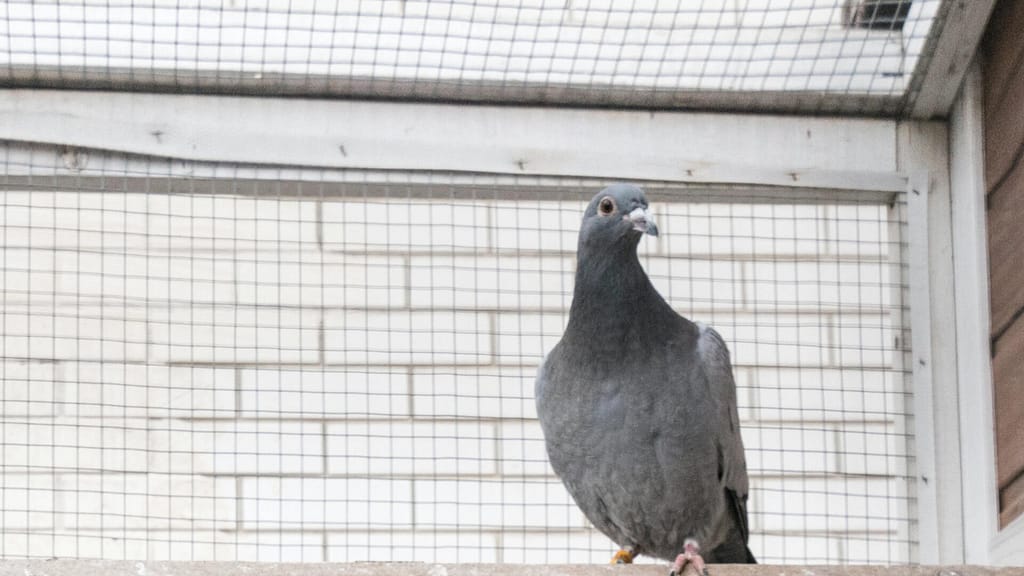
One of the primary advantages of trapping is its humane nature. When executed correctly, it ensures that pigeons are captured without inflicting any physical harm on them. The adaptability of traps is another merit; they can be effectively set up in a range of locations, be it rooftops or balconies, making them suitable for diverse scenarios.
However, trapping does come with its share of disadvantages. The baiting process can be intricate, requiring the right choice of bait—typically corn, peas, or other seeds—to ensure efficacy. An added challenge is the pigeons’ remarkable homing ability. Even if you relocate the birds after trapping, there’s a high likelihood they’ll return unless taken a substantial distance away.
Legally, the waters are a bit murky when it comes to trapping. While feral pigeons, also known as Rock Doves, may not always be protected, other pigeon species might fall under protective regulations. It’s essential to delve into local, state, and federal laws before initiating any trapping endeavors.
What Not To Do: Common Missteps in Pigeon Control
Pigeon control, while necessary in many urban settings, can sometimes be approached in ways that are ineffective, inhumane, or even illegal. It’s essential to be aware of these pitfalls to ensure that the methods employed are both efficient and ethical. Here’s a list of common mistakes to avoid:
Using Poisons or Harmful Chemicals
It might seem like a quick solution, but using poisons or other toxic substances can lead to numerous problems. Not only is it inhumane, causing prolonged suffering to pigeons, but it can also negatively impact other wildlife, pets, or even humans if they come into contact with the substance.
Shooting or Physically Harming the Birds

A common misconception in pigeon control is that shooting or physically harming these birds provides an easy solution. However, in the U.S., the legalities are far from simple. Federal laws protect almost all bird species, with the exceptions mainly being introduced ones such as the Rock Dove (feral pigeon), European Starlings, and House Sparrow (Source).
Importantly, while it might be considered legal to shoot feral pigeons, this action is only permissible within one’s private property. Carrying out such actions in public places is illegal. Despite the legality on private lands, we strongly advise against shooting due to significant safety concerns.
This method not only risks harm to nearby structures and individuals but can also inadvertently impact other protected bird species. For the sake of legality, safety, and humanity, it’s wiser to explore and implement gentler, more effective pigeon control strategies.
Relying Solely on Decoy Predators
While many homeowners and businesses turn to plastic owls or hawks as a deterrent for pigeons, the effectiveness of these decoy predators can be short-lived. Initially, these faux predators might spook the pigeons and cause them to scatter. However, over time, pigeons often become savvy to the deception.
They can discern that these stationary figures pose no real threat. As they acclimate to the presence of these decoys, pigeons will soon overlook them and revert to their usual routines.
Ignoring Local Regulations and Homeowners’ Association Guidelines

When it comes to wildlife control, it’s imperative to understand that regulations can vary significantly depending on the region, city, or neighborhood you reside in. Many areas have specific guidelines or bylaws in place to ensure the humane treatment of animals and to maintain a balance within the ecosystem. Overlooking these regulations can not only result in unintentional violations but may also carry legal repercussions or fines.
Moreover, for those living in communities governed by a homeowners’ association (HOA), there are often additional guidelines or restrictions to consider. These associations aim to maintain the aesthetic and structural integrity of the community, and they may have particular rules about wildlife control methods, devices, or deterrents that can be used within the community boundaries.
Failure to align with these HOA guidelines could lead to conflicts with neighbors or penalties from the association itself. As such, before taking any measures against pigeons or other wildlife, it’s crucial to research local laws and consult any relevant HOA documentation to ensure you’re acting within the prescribed boundaries.
Conclusion
Pigeons present challenges that necessitate informed solutions. Bird spikes, netting, reflective objects, falconry, ultrasonic devices, and gel repellents each offer unique ways to manage these birds, but they also underscore the importance of understanding our shared urban ecosystem.
As we consider pigeon control methods, it’s essential to weigh their practicality, aesthetics, and ethical implications. Balancing these aspects ensures a harmonious coexistence in our ever-evolving urban spaces.
Fact checked by Jacob Petrosky – 10/9/23
